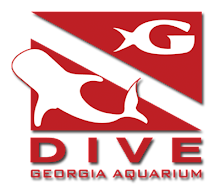Recently, several members of Dive Operations and the Dive Immersion Program went through the Instructor certification class for the Handicapped Scuba Association (HSA). This class introduced existing Dive Masters and Instructors to the skills and challenges required to certify people with disabilities as Open Water Scuba divers. The Dive Immersion Program has several groups of guests with paraplegia, quadriplegia, and visual impairments that dive with us on a regular basis so it is imperative that the staff be prepared to accommodate these guests and make their dives enjoyable.
Taught by Susan Oglesby, Asst. Manager of the Dive Immersion Program, Certified Therapeutic Recreation Specialist and HSA Instructor Trainer, the class had a two-fold purpose. First, it added another level of Instructor or Dive Master certification to those who were already rated as Instructors or Dive Masters and second, it helped prepare us for diving with guests who have disabilities. The class consisted of 10 hours of lecture, 5 hours of confined water (i.e. pool) training, and 4 hours of open water training. The open water section was done in the Ocean Voyager exhibit at the aquarium.
The lecture segment introduced the divers to various types of disabilities such as spinal chord injuries, brain injuries, cognitive disabilities, Cerebral Palsy, amputations, hearing and vision impairments, Multiple Sclerosis (MS), and Muscular Dystrophy (MD). Each has its own unique challenges related to diving but the ones concentrated on were blindness and spinal chord injuries. The lectures also taught how such disabilities affect not only the person’s ability to dive but also how they affect everyday living. The divers learned how spinal chord injuries can affect not only the limbs and extremities but also more internal muscles and organs. There are quite a few things that must be taken into consideration for para- and quadriplegic divers. Things such as catheters and “programs” (the bowel movement process), severely limited abdominal muscle control and Hyperreflexia (high blood pressure resulting from an abnormal stimuli).
One of the more fascinating parts of the lecture dealt with blind divers and how they perceive and communicate via touch and hearing. Because the non-visual senses of a blind person are typically heightened, most blind divers can hear and sense things in the water that sighted divers can’t. They also communicate via hand signals and touching. To simulate what it is like to dive blind, the class was divided into buddy teams. One member of each team was “blind” and wore a blacked-out mask throughout the entire process of gearing up, entering the water, diving, and exiting the water.
 |
| Devin Waddell, one of the DIP Dive Masters, sets up his gear as a blind diver |
 |
| Windsor Gray leads Stacey Schneider to the edge of the pool in preparation for entry |
 |
| Drew Commins helps stabilize his "paraplegic" diving buddy Susan Street |
Quadriplegic divers may require 2 buddies. One should be certified as a Rescue diver or better and the other can be an Open Water diver and is there to be the primary buddy’s buddy. The quad in the exercise needed assistance with every aspect of diving which required the primary buddy be Rescue trained to handle any emergency that might arise. The quad diver’s primary buddy must perform even the most basic skills for them such as mask clearing and equalizing ear pressure.
Several other skills were covered, such as how to control a low functioning quad diver’s buoyancy. It proved to be tricky but if the primary buddy wrapped themselves around the diver to maintain a vertical orientation in the water, then using the quad diver’s BC for control, buoyancy could be maintained with ease.
For the final day of class, all previous skills and simulations were done in the shallow end of the Ocean Voyager exhibit. This added the complications of animals swimming and how to avoid colliding with them. It also made the blind simulation that much more fascinating. Buddys guided each other around, stopping at several places to let the “blind” diver touch parts of the exhibit and indicate when various animals would approach, using tactile signals to represent Whale Sharks, Manta Rays, and Hammerhead sharks.
 |
| Simulating being a diver with quadriplegia, Devin Waddell is supported by his primary buddy, Nonalee Davis while secondary buddy Windsor Gray, stays with him at the surface. |
 |
| Wayne Benton, Janet Leavell, and Barry Leavell look on as members of Dive Ops and the Dive Immersion Program complete their HSA Instructor Training checkout dives. |


No comments:
Post a Comment